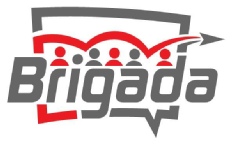In a day and age when seemingly *everybody* links long URL’s to innocent words in the middle of sentences, why does Brigada continue to spell out links on a separate line, with the “http://” in front of the URL? There are several answers:
a) First (and the shortest answer), some (many?) of our readers still print their Brigada editions and hand the paper copies to friends and colleagues in their offices. Did you ever stop to realize that when you print a webpage or email, the link *behind* that bold word is completely invisible? We’ve always believed that, contrary to popular opinion, at least when it comes to web pages and emails, the printed page isn’t very powerful — if the links are all missing. So we spell them out — every time — on their own separate line, so they won’t get mixed up with periods or other punctuation or get mixed in with other words or text. But just as importantly, …
b) Secondly, there’s a philosophical reason too. We’ve always thought it was weird that people would just *blindly* click on a link without paying attention to where they’re going. So we made a commitment long ago that we’d provide the link, regardless of how long it is, and that the link *behind* the link would be exactly the same as the printed link on the page. In other words, unlike other pages, we *SHOW* you exactly where we’re going to send you when you click. Now granted… you could make the argument that one can always hover one’s mouse over the link to verify (since modern browsers then display the link hiding under the link), but we just always thought it was more honest to be straight with you — about where you’re about the fly.
c) Finally, we just like the idea that this “full disclosure practice” would hopefully help people name links logically, if at all possible. Why wouldn’t it be possible that if you go to
it should take you to the world news summary page? (And it does, by the way.) If people would just be a bit more logical about naming their webpages, then the world would be a friendlier place ANYWAY. I mean, what if CNN had named their page, cnn.com/1359799/july/2016/fkdlsifl ??? That just wouldn’t make any sense, eh? So we love letting you SEE the link because it helps the world see how (hopefully) orderly web page creators can be.
That’s all we’ve got to say about that. : )












Hey Doug, An interesting article. However, your transparency claim is a bit misleading. For sure, you do what you claim on the website. However, in the Emails the link tracking process means that what shows on the screen isn’t what is hidden underneath the link. For example, in this article in the Email received, the URL
http://www.cnn.com/world
actually clicks through to:
http://teamexpansion.us10.list-manage1.com/track/click?u=80b5be7bce3917413bb68934c&id=fabb440819&e=984ffadbc4
So the Emails do exactly what you say is misleading. Now, I’m cool with this. I know what is going on and when my Email program jumps up and warns me this might be a scam link I know it is just part of the Email tracking stuff but it isn’t quite honest to claim you don’t do something when you do :(
Wow Andrew. We’re red-faced. This is a feature of MailChimp. For sure — Brigada purists could simply use the Brigada email as an indicator that a new edition is posted, then go to the website and read it there. Because the website DOES follow our directives. In the meantime, we’ll investigate whether or not we can disable the MailChimp feature and ask Mailchimp to provide DIRECT linking. Thanks for pointing this out!
We just tested and, sure enough, the MailChimp default is to redirect recipients through their link-tracking feature. From now on, when we send Brigada email editions, in keeping with our intent, we will no longer track click-throughs. In our tests just now, this DID send us to the exact destination without the interim stop at MailChimp for the click-through count. Thanks for bringing this to our attention, Andrew. That’s the magic of Brigada: User engagement. : )
Andrew beat me to the comment I was going to make.
I agree with your philosophy on transparency in links.
However, I am interested in the click through rate on links in our newsletter. (I would think you would too, as it allows you to gauge the level of interest on the different things you post.) So, is there another way to track the click through rate when bulk mailing through a system like MailChimp?
Not that we can find. So we’re going to give up the click-through data in order to provide users with optimum transparency and honesty. Who cares about tracking — if our participants can’t trust the links we’re providing.